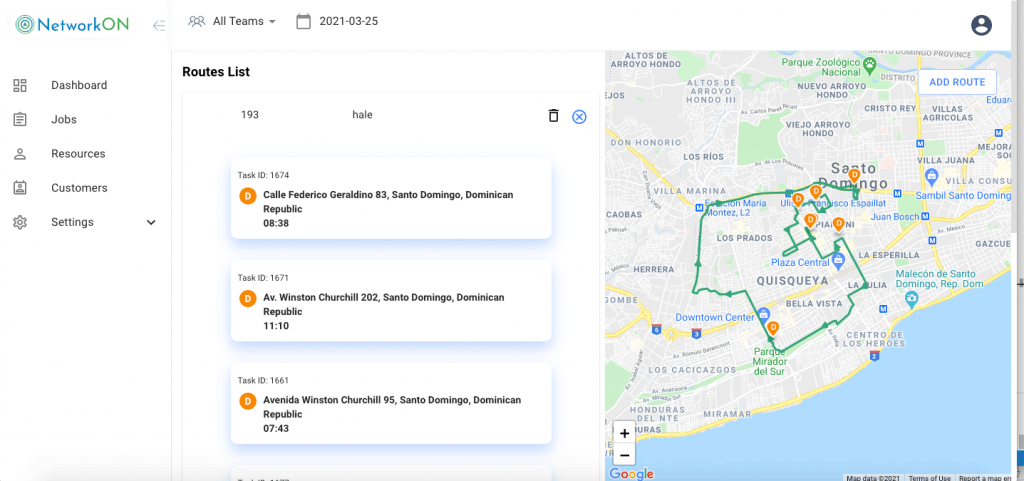Table of Contents
If you run a business that manages a fleet of any kind, the rising cost of transportation most likely has a significant impact on your bottom line.
Post-COVID, the economies have shrunk and the company budgets have become tighter than ever. Success in the fleet management industry isn’t about increasing the number of orders fulfilled anymore, it’s about getting things done in the shortest time and at the lowest possible cost.
What is Route Optimization?
Fleet managers encounter a plethora of last-mile delivery constraints while planning optimal delivery routes.
Route optimization is the process of finding the most cost-efficient path between two points, by considering relevant factors such as the number and location of required stops, time windows of the deliveries, road conditions, and so on.

A route planning or route optimization software automates this task by creating the most efficient route possible based on real-time constraints.
Top Ways Route Optimization Reduces Cost and Increases ROI
With the advancements in technology, a fleet management system with an effective route optimization capability can help you achieve that, and much more.
Read on to discover how:
1. Reduce Downtime
Fleet management companies have to face many variables when planning for their transport operations.
For example, a logistics company has to consider inventories, work orders, capacities, fuel management, loading times, driver work hours, and more to make a plan about their operations.
While scheduling manual operations, you have to take all these factors into account, which considerably adds up to the downtime of vehicles and reduces driver work hours.
However, with route optimization software, you just need to input all the variables, and the system will automatically allocate vehicles, and plan routes in the most optimal way possible.
2. Reduce Fuel and Maintenance Costs
Fuel is the largest single largest contributor to transportation costs. When the fuel prices go up, fleet management companies are required to increase their prices or incur losses. This way, the rising fuel prices increase the overall cost of transport which translates into higher product prices.
With efficient route optimization, the vehicles are driven through optimal routes with a minimum number of stops, which results in lesser miles traveled, lesser idling, and lesser fuel consumed.
When considered on a monthly or a weekly basis, it adds up to a considerable amount of savings. Additionally, vehicles running on the shortest possible route mean less time on the roads, which means lesser wear and tear of the vehicles, resulting in lower maintenance and repair expenses.
3. Better Resource Utilization
An efficient route planning software allows you to generate ROI from the following three main factors:
- You make better use of the drivers by planning routes that make efficient use of each shift. And with accurate planning, you will use fewer vehicles, which will help you reduce expenditure.
- Another important aspect of using route planning software comes from the capability to push back cut-off time for accepting customer orders. This allows you to accept orders later and fulfill them without any pressure on the picking team.
- By scheduling reliable delivery times, you enhance the level of customer experience, which in turn improves customer retention and your competitive advantage.
4. Boost Productivity
Route optimization enables allocation of deliveries to suitable and skilled drivers with sufficient work hours available, which results in the best possible utilization of fleet and human resources.
With the capability to maximize the number of deliveries in each shift, companies can increase the number of shifts as per their requirement to save time and increase productivity.
This also allows fleet managers to run their vehicles with extra shifts and pick up returns or empty containers in the same shifts, resulting in the reduction of third-party expenses.
5. Increase Customer Retention
Optimal route optimization techniques enable you to complete on-time deliveries with accurate ETAs and more frequent communication with the customers that adds up to an excellent customer experience.
In the long run, this translates into a happier customer base with increased levels of satisfaction, which in turn increases your retention rates.
6. Drive Ongoing Improvements
Advanced fleet management and route optimization techniques with embedded analytics evaluate not only the real time fleet operations but also carry out the analysis of the impact of changing vehicle capacity, increasing customer locations, and dynamic delivery dates.
This allows companies to foresee the financial impact of a new decision or technology to be implemented. Also, information garnered from vehicle telematics, customers, drivers, and planners can also be used to generate insights and improve the system to become more productive.
How Efficient Route Optimization Software builds Brand Loyalty
Apart from bringing down a fleet owner’s operating costs, route optimization also helps in building solid brand loyalty.
With price and products being no longer the differentiating factors for brands, modern-day customers have become more demanding as they now expect faster shipping options and same-day deliveries.
According to an Oracle study, 36% of US customers say that they are unlikely to order again from the same brand that failed to give them a satisfactory delivery service experience.
And with the acclimatization provided by e-commerce portals, modern consumers find it easy to find a replacement rather than patronizing a single brand.
With route optimization software, businesses can provide accurate ETAs, real time alerts, accurate tracking, and more. By meeting these expectations, companies can build a pool of loyal patrons and maximize their bandwidth.

Key Factors to Keep in Mind for Selecting a Route Optimization Software
1. Order-Vehicle Constraints:
Route optimization software must include real-time order-vehicles constraints instead of just focusing on cold, hard data. For instance, medicines, electronics, and other specific types of products require special delivery vehicles and sometimes can’t be shipped with other generic items. Route optimization software must consider such constraints to minimize inefficiencies.
2. Accurate Geocoding:
The majority of the route optimization software available in the market supports geocoding. However, pinpointing an address to its exact location on the map is a complicated process. It greatly involves the understanding of ambiguous addresses and local contexts to ensure accurate geocoding. A route optimization software with a stellar database of local addresses can be a big competitive advantage.
3. Historical Data Inspection:
A route optimization software must examine historical data related to riders, customers, and time of the day. A rider’s historical data determine their skills, preferred time of delivery, and expertise. While a customer’s historical data tells about their preferred time slots and availability, and historical data related to a given time of day gives information about the prevailing traffic conditions.
An efficient route optimization software will consider all three sources and plan routes accordingly.
Takeaway
Choosing the right route optimization software can have a profound impact on fleet operations, profitability, and overall customer experience. Businesses that have employed advanced fleet management software and superior route optimization capabilities are assured of tangible cost savings within the first month of implementation.
To know more about how our fleet management and route optimization experts can help you streamline your business operations and increase profitability, visit our website or get in touch with our team at info@networkon.io.





0 Conversations